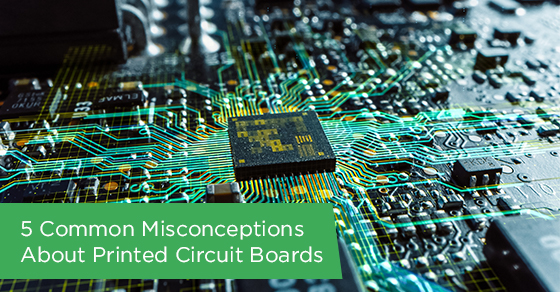5 Common Misconceptions About Printed Circuit Boards
Even though it can be said that printed circuit boards (PCBs) make the modern world possible, as they are a crucial component in nearly every electronic device, they are still often misunderstood by many in terms of their design and function.
PCBs are electronic assemblies that use copper conductors to create electrical connections between components, and provide mechanical support for electrical components so that a device can be mounted in an enclosure.
The mechanical structure of printed circuit boards is made up of an insulating material laminated between conductor layers. They also include copper traces, pads, and conductive planes.
During the manufacturing process, the board’s inner copper layers need to be etched, leaving traces of copper to connect components within the circuit. Even the most basic PCBs need to be carefully designed due to the complexity of their parts and function.
What are some of the biggest misconceptions about PCBs?
Outside certain professional circles, little is known about PCBs and how they function. Even within the profession of PCB creation, there are some common misconceptions about the design process. Failing to dispel these misconceptions can negatively impact a PCB designer’s ability to create consistently high-quality boards.
The following are some of the most common misconceptions about PCBs and their design process:
1. Rigid and flexible circuits have the same design rules
Since the functionality of rigid and flexible circuits is so similar despite their differences in materials, it is often believed that the design schematics of these two circuit types should be the same.
However, this is a misconception, as flexible circuits need to be designed to minimize locational stresses when bent, which is not the case with rigid circuits. In addition, there are some major differences in the dimensional stability of the base materials used in either of these circuit types.
2. Via-in-pad damages your circuit board
It is true that, sometimes, if via-in-pad is used incorrectly, it can have a negative impact on your circuit board, as failing to cap for a via-in-pad or mask can result in plating chemicals becoming trapped.
However, when via-in-pad is used correctly, this is not an issue. Indeed, via-in-pad has several important uses, such as placing close bypass caps, helping with thermal management, and simplifying pitch BGA routing. Therefore, you should not avoid using this helpful tool just because of misconceptions you may have heard about the damage it can cause.
3. Making your design beautiful should be a priority
PCB engineers often approach the design of their circuit boards in a similar way to how an artist approaches a blank canvas, and they frequently prioritize the elegance and fluidity of their design.
The reality, however, is that rather than the aesthetics of your board, you should focus on whether the finished product abides by the laws of physics, works well with the materials available, and is possible to make with the available tools.
It is also important to remember that designs that look good on paper do not always translate well when applied in the real world. So, always keep logical limitations in the back of your mind during the design process to avoid wasting your time and money.
4. It doesn’t matter what kind of design software you use
Some people believe it doesn’t matter what type of design software you use to help create printed circuit boards, as all of this software is developed for the same purpose and has the same basic functions.
However, this could not be further from the truth. In addition to there being several different design software options available at various price points, the features available from one design software to the next also vary. For instance, only some design software has a support community for when you have questions or run into problems.
Additionally, some software has better MCAD integration, while others are better at managing library components and designs. You should consider your priorities and do background research into all of your options before selecting a design software that is the right fit for you.
5. Components can be placed anywhere on the board
Some PCB engineers believe it is possible to place components anywhere that they like on the board without compromising its effectiveness, but this is yet another big misunderstanding.
As a PCB engineer, you do not have free range over where you would like to position your components. In fact, if each component is not placed in the specific area where it belongs, it may not work properly with the electrical scheme of the board. Therefore, it is incredibly important to learn where each component should be placed and stick to that placement throughout all designs.
Why Circuits Central Is a Reliable Printed Circuit Board Manufacturer
If you are searching for reliable and professional printed circuit board manufacturers in Toronto, Circuits Central is here to help. We are a world-class electronics manufacturer, and we offer a full range of PCB manufacturing services, including consigned to full turnkey manufacturing, material procurement, prototyping, and PCB assembly and testing.
We can provide guidance or assistance in several other key areas. For over 25 years, we have been serving customers in various industries by designing and manufacturing PCBs of the highest possible quality.
No matter what stage you are in the process of designing or manufacturing your PCB, we can offer valuable help and solutions that will make your life easier and your product better.
We will tailor our approach to your specific needs and ensure that your end product turns out well, whether it is a simple design or an incredibly complex one. Our engineers have the skills, knowledge, and experience to guarantee exceptional work in every project that they take on.
For more information about why we are one of the best-printed circuit board manufacturers in Toronto, or to learn more about our wide variety of PCB design and manufacturing services, call Circuits Central at 1 (888) 602-7264 or contact us here.

